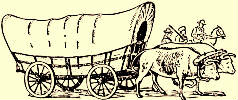
Benjamin Long, 1787-1859, helped organize the town of Tonawanda, NY. He was a farmer, businessman and politician.
In December of 1828, Benjamin and Mary Hershey Long arrived in the Village of Tonawanda, New York, from Lancaster County, Pennsylvania.
They had traveled over 330 miles in a covered wagon drawn by oxen, with their five daughters, ranging in age from 6 months to 16 years. They must have had plenty of blankets!
The prime land Mr. Long purchased was at the mouth of Ellicott Creek where it meets Tonawanda Creek and the Erie Canal.
The Erie Canal was completed in 1825. Its towpath passed directly
|
in front of the homestead. According to one daughter, Christiana, the tiny settlement of Tonawanda, at that time, was comprised of only 13 other buildings, all clustered around the canal.
After the spring thaw in 1829, Benjamin, friends, and other workers, built the house we now know as the Long Homestead. This was not to be a small log cabin in the woods. It is a three-story, 10-room house to accomodate a family of 7, or more. Indeed, the Long family grew to include a son and another daughter for a total of 9: father, mother, and 7 children. No wonder they needed a big house!
And muscle power to build it. Keep in mind this was the early 19th Century. There were no major contractors with power tools and heavy equipment to build subdivision-style frame housing with pre-cut 2x4s.
The structure is a  hand hewn log home. White oak trees for the beams, and black walnut trees hand hewn log home. White oak trees for the beams, and black walnut trees
|
for the walls, were cut down with axes and saws on the spot! The house exterior is cedar clapboard siding. The reason for the cedar siding is it deters wood-boring insects, such as termites. The oak and walnut were good for strength and appearance, but were susceptible to infestation.
The foundation exterior is Medina red sandstone. (Medina and Tonawanda are both former ports on the Erie Canal, about 37 miles apart in Western New York, near Buffalo.) Recent preservation work has been done on painting and brick.
Today, the Long Homestead is decorated with antique furnishings of the Empire and Early Victorian periods, 1810-1860, to reflect the lifestyle of a well-to-do family of that era. In addition, museum volunteers have regularly assembled temporary displays of Society artifacts and on-loan items over the past several seasons. These displays have included quilts, dolls, toys, dresses, and uniforms.
|